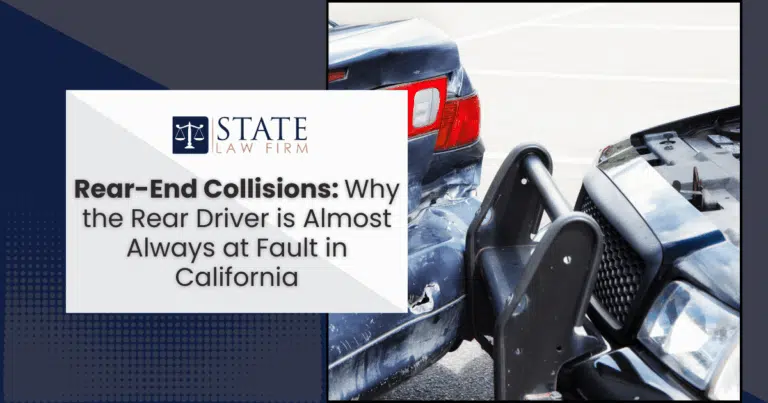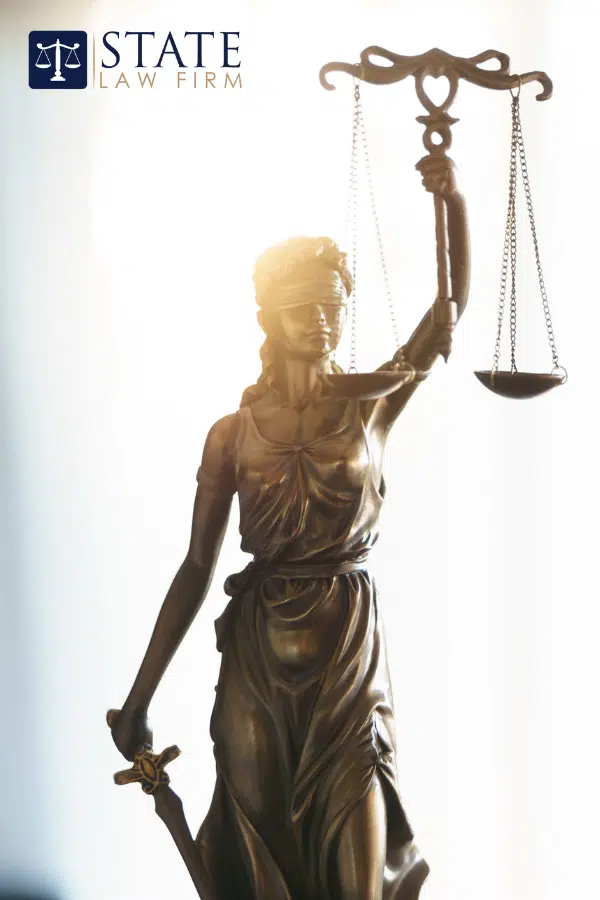Rear-end collisions are among the most common types of car accidents on California roads, and they can happen in the blink of an eye. Whether it’s due to tailgating, texting while driving, or simply failing to react in time, the consequences can range from minor vehicle damage to life-altering injuries. In fact, according to the National Highway Traffic Safety Administration, rear-end crashes account for nearly 29% of all traffic accidents in the U.S. (NHTSA).
If you’ve been injured in a rear-end accident in California, you may be wondering what your legal rights are—and how fault is determined. At State Law Firm, our Sherman Oaks-based personal injury attorneys are here to guide you through the process. We’re a boutique law firm led by a team of driven young attorneys committed to helping our clients take on tough cases and recover what they deserve.
This article will walk you through everything you need to know about rear-end accidents in California, including common causes, legal frameworks, insurance implications, and the steps to take after a crash to protect yourself and your case.
Understanding Rear-End Collisions: Common Causes and Scenarios
Rear-end collisions often occur when one driver follows another too closely or fails to react quickly enough. Although these incidents may seem straightforward, they can involve complex legal and factual details, especially when serious injuries are involved.
Common causes of rear-end accidents include:
- Tailgating is one of the most frequent causes. Even at low speeds, following too closely reduces reaction time.
- Sudden stops: If the lead driver brakes unexpectedly, the rear driver may not have time to react.
- Poor weather or road conditions: Rain, fog, or slippery roads can lead to delayed stopping.
- Inattention or distraction: Even looking away from the road for a second can result in a crash.
- Traffic congestion and stop-and-go driving: High-density areas like Los Angeles increase the likelihood of rear-end crashes.
Pro Tip: Leave at least one car length of distance for every 10 mph you’re traveling. In dense traffic zones, that space is your safety net—and it can become your legal protection, too.
The Legal Framework Surrounding Rear-End Collisions in California
California law presumes the rear driver is at fault in most rear-end accidents. This is based on California Vehicle Code Section 21703, which states that drivers must not follow another vehicle “more closely than is reasonable and prudent.”
Still, fault isn’t always automatic. Courts and insurance adjusters consider:
- Whether the lead driver made an unreasonable stop
- Road and weather conditions
- Any mechanical failures or vehicle defects
California also follows pure comparative negligence, which means fault can be shared. Even if the front driver is partially responsible (e.g., the brake lights weren’t working), they may still recover damages, reduced by their percentage of fault.
If you’re unsure how these laws apply to your case, speaking with a car accident attorney can clarify your rights. At State Law Firm, we analyze every angle to help our clients build strong, facts-driven claims.
The Role of Distracted Driving in Rear-End Accidents
In today’s fast-paced world, distraction is one of the most dangerous threats on the road.
According to the California Office of Traffic Safety, distracted driving claimed the lives of over 3,000 people nationally in 2022, with mobile device use remaining a top contributor. In rear-end collisions, distractions like texting or checking GPS are frequently to blame.
Common driver distractions include:
- Texting or phone use
- Adjusting navigation or music apps
- Eating or drinking while driving
- Talking to passengers or handling pets
Pro Tip: If you’re rear-ended and suspect distracted driving played a role, try to document the other driver’s behavior at the scene (or shortly after), and let your attorney know. Witnesses, dash cams, and even phone records can help prove what happened.
Insurance Implications for the Rear Driver in a Collision
In rear-end collisions, the rear driver’s insurance is usually the first to be tapped for liability. Insurance companies will investigate fault thoroughly, especially when injuries or high vehicle damage are involved.
Here’s what typically happens:
- The rear driver’s insurer pays for the front driver’s vehicle repairs and medical costs.
- If the rear driver believes the front driver was partially at fault, comparative fault principles may apply.
- The insurer may try to settle quickly, often for less than your case is worth.
Pro Tip: Don’t accept an insurance settlement before talking to a lawyer, especially if you’re experiencing ongoing pain, discomfort, or missed work. An attorney can help protect your interests and ensure all damages are considered.
What to Do After a Rear-End Collision: Steps to Protect Yourself Legally and Physically
Your steps after a collision can make or break your personal injury case.
Immediately after a rear-end crash, you should:
- Check for injuries and call 911 if needed
- Document the scene: Take photos of all vehicles, license plates, road signs, and your injuries.
- Exchange information with the other driver, but avoid discussing fault.
- File a police report, even if the damage appears minimal.
- Seek medical attention immediately, even if you feel “fine.”
- Contact a qualified car accident attorney to discuss next steps
Why this matters: Insurance companies will seek any reason to minimize your claim. By documenting everything and acting quickly, you protect your rights and set the stage for a stronger recovery.
At State Law Firm, we know that no two rear-end accidents are exactly alike. Whether you’re recovering from whiplash or facing long-term consequences from a high-speed crash, we’re here to help you navigate California’s complex personal injury system. As a boutique firm, we take a hands-on approach—digging deeper, litigating harder, and standing beside our clients every step of the way.
Our team is ready to support you if you’ve been injured in a rear-end collision and need guidance. Visit our Sherman Oaks car accident lawyer page to learn more or request a free consultation.


